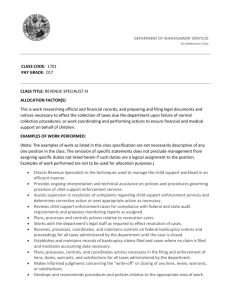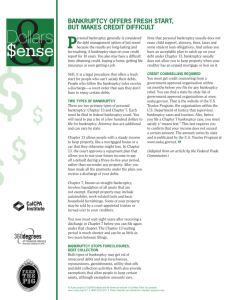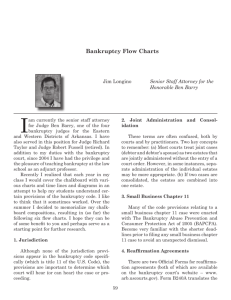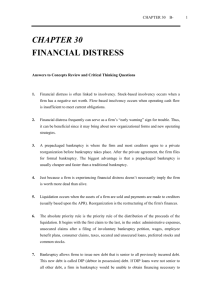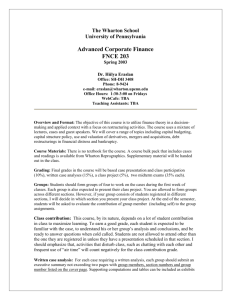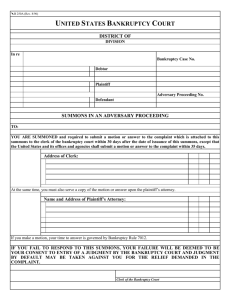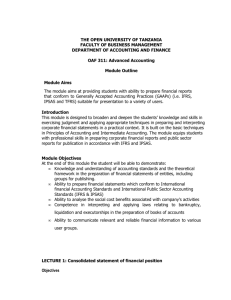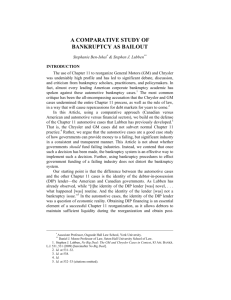Financial Distress and Corporate Restructuring
advertisement
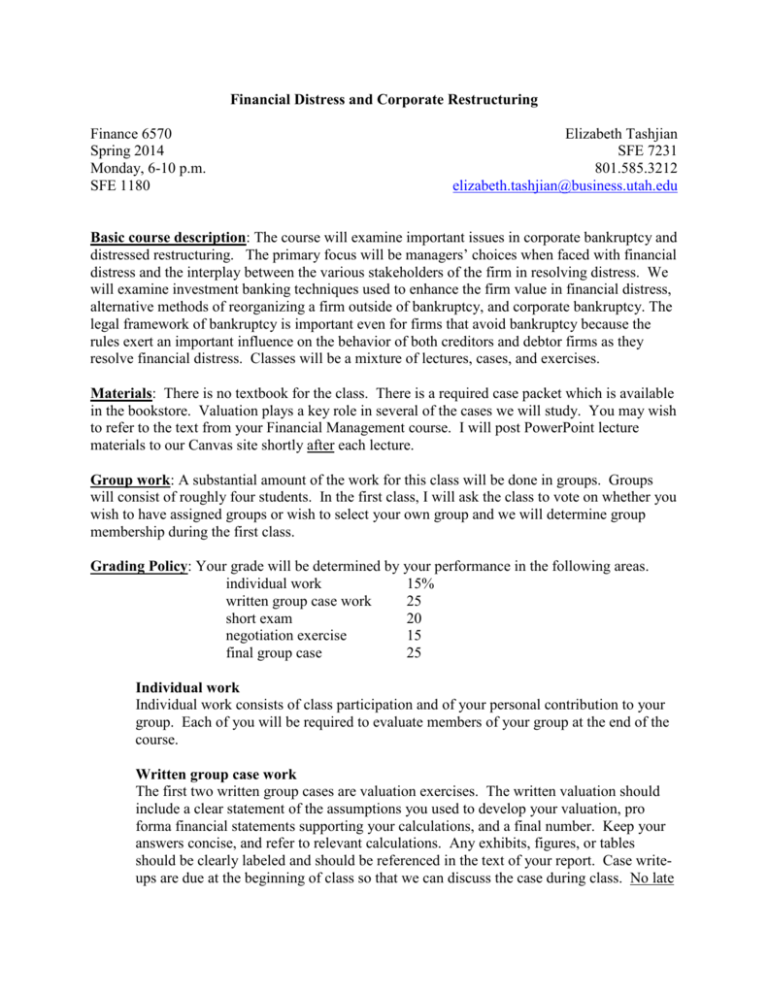
Financial Distress and Corporate Restructuring Finance 6570 Spring 2014 Monday, 6-10 p.m. SFE 1180 Elizabeth Tashjian SFE 7231 801.585.3212 elizabeth.tashjian@business.utah.edu Basic course description: The course will examine important issues in corporate bankruptcy and distressed restructuring. The primary focus will be managers’ choices when faced with financial distress and the interplay between the various stakeholders of the firm in resolving distress. We will examine investment banking techniques used to enhance the firm value in financial distress, alternative methods of reorganizing a firm outside of bankruptcy, and corporate bankruptcy. The legal framework of bankruptcy is important even for firms that avoid bankruptcy because the rules exert an important influence on the behavior of both creditors and debtor firms as they resolve financial distress. Classes will be a mixture of lectures, cases, and exercises. Materials: There is no textbook for the class. There is a required case packet which is available in the bookstore. Valuation plays a key role in several of the cases we will study. You may wish to refer to the text from your Financial Management course. I will post PowerPoint lecture materials to our Canvas site shortly after each lecture. Group work: A substantial amount of the work for this class will be done in groups. Groups will consist of roughly four students. In the first class, I will ask the class to vote on whether you wish to have assigned groups or wish to select your own group and we will determine group membership during the first class. Grading Policy: Your grade will be determined by your performance in the following areas. individual work 15% written group case work 25 short exam 20 negotiation exercise 15 final group case 25 Individual work Individual work consists of class participation and of your personal contribution to your group. Each of you will be required to evaluate members of your group at the end of the course. Written group case work The first two written group cases are valuation exercises. The written valuation should include a clear statement of the assumptions you used to develop your valuation, pro forma financial statements supporting your calculations, and a final number. Keep your answers concise, and refer to relevant calculations. Any exhibits, figures, or tables should be clearly labeled and should be referenced in the text of your report. Case writeups are due at the beginning of class so that we can discuss the case during class. No late assignments will be accepted. Each team should submit a single report. All team members will receive the same grade for each write up. Groups should do their work independently. Collaborating with people outside your group will be treated as cheating and result in your group receiving a failing grade on the assignment. Short exam The exam will consist primarily of short answer questions on bankruptcy and distressed reorganization. There may be one or two very short computational problems. You will be allowed to use a financial calculator and three pages (single sided) of notes. Negotiation exercise The negotiation exercise involves developing and voting on a plan of reorganization. In class, you will be assigned to a group. Each group will be given the role of an important class of claimholders in the bankruptcy case. The groups will negotiate a plan (or have a plan crammed down on them) during the exercise. You will be given a template for the plan which you will complete and turn it in during class at the end of the negotiation exercise. Part of the grade on the exercise will be determined by the overall outcome of the exercise, and part by the performance of each individual group. Each member of a group will be given the same grade on the exercise. Final exam (take-home) The final exam will be a group case and is due no later than Tuesday, February 18, at 4:00 p.m. Any exhibits, figures, or tables should be clearly labeled and should be referenced in the text of your report. Identify your assumptions clearly. Be sure to cite your sources. Each group should turn in a single document. You may not collaborate with people outside your group. Each person who contributes to the report will receive the same grade. ADA Policy: The University of Utah David Eccles School of Business seeks to provide equal access to its programs, services, and activities for people with disabilities. If you will need accommodations in this class, reasonable prior notice needs to be given to the instructor and to the Center for Disability Services, http://disability.utah.edu, 160 Olpin Union Building, (801) 581-5020 (V/TDD) to make arrangements for accommodations. All written information in this course can be made available in alternative format with prior notice to the Center for Disability Services. David Eccles School of Business Statement of Professional and Ethical Conduct: Because of the importance of professional and ethical behavior in business, and its emphasis in our program, professional or academic misconduct is not tolerated in the David Eccles School of Business. Students are expected to adhere to the standards of behavior outlined in the University of Utah Code of Student Rights and Responsibilities (Policy 6-400). Students engaging in behavioral misconduct could be subject to suspension or dismissal from the University. Students involved in any form of academic misconduct, including but not limited to cheating on tests, plagiarism and collusion may, at the instructor’s discretion, receive a failing grade in the course, examination, or academic assignment. In addition to or instead of this sanction, the instructor may refer the case to the Student Behavior Committee for hearing. If the instructor chooses not to do so, the Associate Dean for Academic Affairs, after appropriate investigation, may do so along with a recommendation to dismiss the student from the Business School. If, after hearing the evidence, the Committee determines that the student in question is guilty of the misconduct charged, the Committee may impose sanctions in addition to those taken by the professor. If the academic dishonesty is not proven, the instructor must rescind any sanctions imposed and will be required to evaluate the student’s performance with the assumption that there has been no misconduct. The School will treat the student likewise. If a student suspects another student of academic misconduct, he/she should refer the incident to the instructor, the appropriate department, the Associate Dean for Academic Affairs, or the Student Behavior Committee, administered by the Associate Dean of Students, 270 Union. Class Schedule and Reading Assignments Finance 6570 Spring 2014 Cases should be prepared before class. See the next page for written assignments and for in-class discussion questions. Date Lecture topic Case assignment January 6 Financial distress; liquidation and Chapter 11 bankruptcy January 13 Out-of-court restructuring National Convenience Stores January 27 Outcomes in distress; in-class negotiation exercise Cumberland Worldwide Corp (A) February 3 Midterm exam; 363 sales; predicting bankruptcy Prepare for the exam; Massey-Ferguson, 1980 February 10 Guest speaker, Annette Jarvis, Partner at Dorsey Accounting Fraud at WorldCom; Chrysler’s Sale to Fiat *There will be no class January 20, in observance of Martin Luther King day. Annette W. Jarvis is the Partner-in-Charge of Transactions. Awarded the 2007 Large Company Transaction of the Year Award (Turnaround Management Association) in recognition of her work in the USA Capital Commercial Mortgage cases, Ms. Jarvis has extensive experience in representing financial institutions, debtors, trustees, examiners, creditors' committees, creditors, indenture trustees, equity holders, public bond holders and purchasers of assets in Chapter 11 bankruptcy cases. Annette has strong, successful experience in receivership cases, representing receivers and acting as a receiver. She has also handled SIPC cases brought under SIPA, and has experience in state insurance rehabilitation and liquidation cases. She has been named one of The Best Lawyers in America in Bankruptcy and Creditor-Debtor Rights Law, elected as a Fellow in the American College of Bankruptcy, selected as a Top 100 Mountain States Super Lawyer, and honored as one of Utah's "Legal Elite" (Utah Business Magazine). http://www.dorsey.com/jarvis_annette/ Assignment Sheet – Finance 6570 Spring 2014 Jan 13 Each group should prepare a single written valuation of National Convenience Stores, Inc. Your written valuation should include a clear statement of the assumptions you used to develop your valuation, pro forma financial statements supporting your calculations, and a final number. The written assignment is due at the beginning of class. Each group member should bring a copy of the report to use during class discussion. Discussion questions for class: you do not need to address these questions in your written report, but think about them before coming to class. 1. What do you think about Morton’s recapitalization plan? 2. Does your answer differ depending on whether you or a bank lender, a preferred stockholder, or other claimholder? Jan 27 Each group should submit a written valuation for Cumberland at the beginning of class. See the syllabus for guidelines for case write-ups. In class, you will be assigned to a group that will assumet the role of a particular type of claimholder in the Cumberland Worldwide Corp. case. Your group should come prepared to negotiate with other stakeholders. Feb 3 There will be a midterm exam which will last about 75 minutes. Prepare the following discussion questions for class (Massey-Ferguson, 1980). I will select people at random to answer questions on the case. You do NOT need to submit written responses to these questions. 1. Assess the strategies that Massey pursued through 1976. 2. What went wrong after 1976? 3. Why, fundamentally, did Massey get into trouble? 4. Assess the various alternatives available to Massey at the time of the case. 5. What restructuring plan would your propose? 6. What do you think will happen if your plan is adopted? Feb 10 Read the WorldCom case. Be prepared to discuss the following questions. You do NOT need to submit written responses. 1. 2. 3. What are the pressures that lead executives and managers to commit fraud? Why weren’t the actions taken by WorldCom mangers not detected earlier? What processes or systems might be used to prevent similar situations in the future? Is that enough? Read the Chrysler case. Prepare the following questions for class. You do not have to hand in your responses, but I will call on a group to begin. 1. Look back to December 2008. Lay out the possible strategies available to Chrysler and briefly describe the pros and cons of each. 2. Is Chrysler a good candidate for a 363 sale? 3. Use examples from the case to illustrate the benefits and costs of a 363 sale relative to the more conventional 1129 process. 4. Who wins and who loses if the 363 sale to Chrysler is allowed to proceed? 5. Under the proposed sale, the UAW will end up with cash, stock, and debt, yet secured creditors are received cents on the dollar and junior debtholders, unsecured debtholders, and equityholders receive nothing. Is this fair? 6. Why did the government get involved in this case? Final Exam: Due Tuesday, February 18, at 4 p.m. You may hand in a hard copy to the finance office (SFE 7126) or email me a copy of the report. If you email the report, please be sure it is formatted to print. The final exam is a paper evaluating a public company that entered Chapter 11 bankruptcy, emerged as a public company at least two years ago, and remains as a public company today. Your paper should be about 10 pages long. Section 1 of your paper should describe the events leading up to the Chapter 11 filing (30 points), section 2 should describe what happened in the bankruptcy with a particular focus on the financial consequences for the claimholders (40 points), and section 3 should describe what has happened since the firm emerged from Chapter 11 (30 points). It is critical to acknowledge your sources appropriately. Failure to cite sources appropriately may lead to a failing grade in the course. Each group must choose a different company. In the event that more than one group selects the same company, the group notifying me of their choice first will be assigned that company. Choosing a company • A good source of company names is Lynn LoPucki’s Bankruptcy Research Database, available at http://lopucki.law.ucla.edu/ . If you click on the “online version” tab, you can sort on key variables, such as outcome. • Before you choose a company, be sure you can get data on the Plan of Reorganization (see instructions below). In section 2, be sure to identify the separate classes of claimholders. Specify the amount of each class’s claim and what the class received. Try and value the securities at emergence. (You may need to assume that the debt is valued at its face amount; you may be able to get emergence stock prices from Yahoo or Google.) Was absolute priority violated? If so, can you estimate the amount of the deviations from priority? Information Sources Bankruptcy information – LexisNexis, available from Marriott Library 1. Go to the Marriott Library site http://lib.utah.edu/index 2. Click on Research Databases; click on L; scroll down to LexisNexis Academic and click (if you are accessing the library off campus, you will need to log in using your CIS ID and password) 3. Click on Search by Content Type (above the search box, on the right) 4. Select Company Profiles from the Companies section 5. Click on Advanced Options beneath the search box and check Bankruptcy DataSource 6. Type in your company name; note that sometimes the legal name of the company differs from the commonly used name 7. You will get a long list of articles and documents about the company’s bankruptcy; you may also find references to other companies who are suppliers, creditors, or investors in your company 8. Be sure there is a usable summary of the Plan of Reorganization before selecting a company (Bankruptcy DataSource creates a summary of the terms of the POR for most large companies) Post-emergence financial information – the best source is often a company’s 10-K. 10-Ks frequently are available on the company’s website or in LexisNexis. If you use LexisNexis, on the Content Type, select SEC Reports from the Company section and then check Form10-K under Advanced Options. You will probably want to limit the dates on your search to keep the number of hits manageable. 10-Ks are big, but they contain a lot of useful information, including financial statements, information on values and numbers of outstanding securities, and a written discussion about the company’s performance. News reports – LexisNexis (under All News in the Content Type; under Advanced Options be sure to include Newswires) and websites of national newspapers and magazines are good sources of news stories. You will probably want to limit dates in your search.


